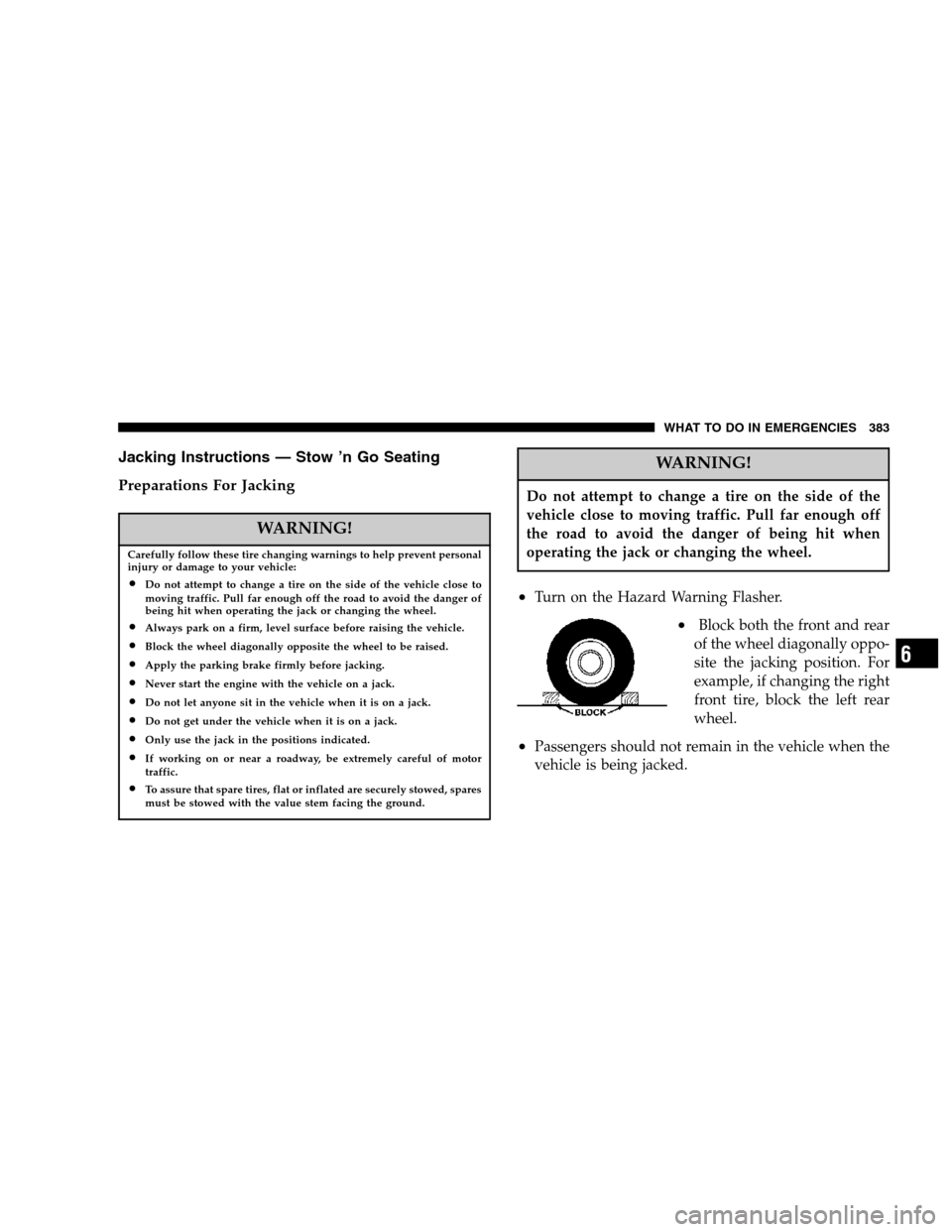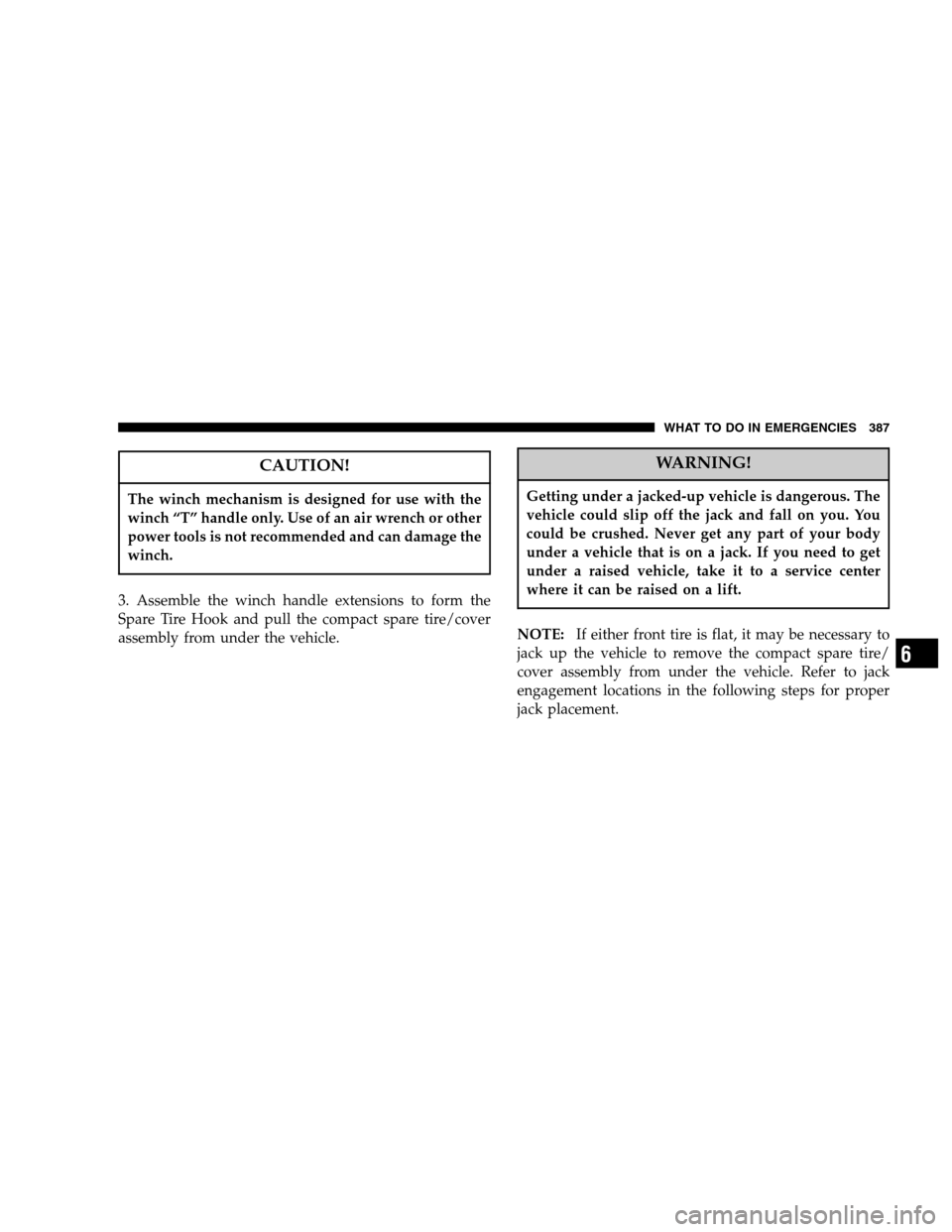CHRYSLER TOWN AND COUNTRY 2007 4.G Owners Manual
Manufacturer: CHRYSLER, Model Year: 2007, Model line: TOWN AND COUNTRY, Model: CHRYSLER TOWN AND COUNTRY 2007 4.GPages: 504, PDF Size: 2.21 MB
Page 381 of 504

IF YOUR ENGINE OVERHEATS
In any of the following situations, you can reduce the
potential for overheating by taking the appropriate ac-
tion.
•On the highways — Slow down.
•In city traffic — While stopped, put transmission in
neutral, but do not increase engine idle speed.
NOTE:There are steps that you can take to slow down
an impending overheat condition. If your air conditioner
is on, turn it off. The air conditioning system adds heat to
the engine cooling system and turning off the A/C
removes this heat. You can also turn the Temperature
control to maximum heat, the Mode control to floor, and
the fan control to High. This allows the heater core to act
as a supplement to the radiator and aids in removing heat
from the engine cooling system.
CAUTION!
Driving with a hot cooling system could damage
your vehicle. If temperature gauge reads “H”, pull
over and stop the vehicle. Idle the vehicle with the
air conditioner turned off until the pointer drops
back into the normal range. If the pointer remains on
the “H”, turn the engine off immediately, and call for
service.
WHAT TO DO IN EMERGENCIES 381
6
Page 382 of 504

WARNING!
A hot engine cooling system is dangerous. You or
others could be badly burned by steam or boiling
coolant. You may want to call a service center if your
vehicle overheats. If you decide to look under the
hood yourself, see Section 7, Maintenance, of this
manual. Follow the warnings under the Cooling
System Pressure Cap paragraph.
JACKING AND TIRE CHANGING
WARNING!
•Getting under a jacked-up vehicle is dangerous. The
vehicle could slip off the jack and fall on you. You
could be crushed. Never get any part of your body
under a vehicle that is on a jack. If you need to get
under a raised vehicle, take it to a service center
where it can be raised on a lift.
•The jack is designed to use as a tool for changing
tires only. The jack should not be used to lift the
vehicle for service purposes. The vehicle should be
jacked on a firm level surface only. Avoid ice or
slippery areas.
•For vehicles equipped with Stow ’n Go seating, if it
is necessary to retrieve the spare tire from under the
vehicle on the side of the vehicle close to moving
traffic. Pull far enough off the road to avoid the
danger of being hit.
382 WHAT TO DO IN EMERGENCIES
Page 383 of 504

Jacking Instructions — Stow ’n Go Seating
Preparations For Jacking
WARNING!
Carefully follow these tire changing warnings to help prevent personal
injury or damage to your vehicle:
•Do not attempt to change a tire on the side of the vehicle close to
moving traffic. Pull far enough off the road to avoid the danger of
being hit when operating the jack or changing the wheel.
•Always park on a firm, level surface before raising the vehicle.
•Block the wheel diagonally opposite the wheel to be raised.
•Apply the parking brake firmly before jacking.
•Never start the engine with the vehicle on a jack.
•Do not let anyone sit in the vehicle when it is on a jack.
•Do not get under the vehicle when it is on a jack.
•Only use the jack in the positions indicated.
•If working on or near a roadway, be extremely careful of motor
traffic.
•To assure that spare tires, flat or inflated are securely stowed, spares
must be stowed with the value stem facing the ground.
WARNING!
Do not attempt to change a tire on the side of the
vehicle close to moving traffic. Pull far enough off
the road to avoid the danger of being hit when
operating the jack or changing the wheel.
•Turn on the Hazard Warning Flasher.
•Block both the front and rear
of the wheel diagonally oppo-
site the jacking position. For
example, if changing the right
front tire, block the left rear
wheel.
•Passengers should not remain in the vehicle when the
vehicle is being jacked.
WHAT TO DO IN EMERGENCIES 383
6
Page 384 of 504

Jack Location — Stow ’n Go Seating
The jack, jack handle and winch handle tools are stowed
behind the rear left side trim panel in the rear cargo area.
Pull up on the lever to release the cover.Remove the scissors jack and jack handle by rotating the
small wing nut to the left. Also remove the tool pouch
containing the spare tire winch handle tools, which is
located next to the jack and jack handle.
Jack LocationJack Removal/Installation
384 WHAT TO DO IN EMERGENCIES
Page 385 of 504

Spare Tire Stowage — Stow ’n Go Seating
For vehicles equipped with Stow ’n Go seating, the spare
tire is stowed inside a protective cover located under the
center of the vehicle by means of a cable winch mecha-
nism. The “spare tire drive” nut is located on the floor,
under a plastic cap between the front seats.
The tool pouch contains three pieces and can be as-
sembled into a Spare Tire Hook to remove the compact
spare tire/cover assembly from under the vehicle or a
Winch “T” Handle to raise/lower the compact spare
tire/cover assembly.
Stow ’n Go Tools
WHAT TO DO IN EMERGENCIES 385
6
Page 386 of 504

Jacking Instructions — Stow ’n Go Seating
1. Loosen (but do not remove) the wheel lug nuts by
turning them to the left one turn while the wheel is still
on the ground.
2. To remove the compact spare tire/cover assembly,
assemble the winch handle extensions to form a “T’ and
fit the winch “T” handle over the drive nut. Rotate the
nut to the left until the winch mechanism stops turning
freely, this will allow enough slack in the cable to allow
you to pull the spare tire out from under the vehicle.
Spare Tire Removal
386 WHAT TO DO IN EMERGENCIES
Page 387 of 504

CAUTION!
The winch mechanism is designed for use with the
winch “T” handle only. Use of an air wrench or other
power tools is not recommended and can damage the
winch.
3. Assemble the winch handle extensions to form the
Spare Tire Hook and pull the compact spare tire/cover
assembly from under the vehicle.
WARNING!
Getting under a jacked-up vehicle is dangerous. The
vehicle could slip off the jack and fall on you. You
could be crushed. Never get any part of your body
under a vehicle that is on a jack. If you need to get
under a raised vehicle, take it to a service center
where it can be raised on a lift.
NOTE:If either front tire is flat, it may be necessary to
jack up the vehicle to remove the compact spare tire/
cover assembly from under the vehicle. Refer to jack
engagement locations in the following steps for proper
jack placement.
WHAT TO DO IN EMERGENCIES 387
6
Page 388 of 504

4. When the compact spare tire/cover assembly is clear
of the vehicle, stand the tire/cover assembly upright and
remove the wheel spacer by squeezing the two retaining
tabs together.5. There are two jack engagement locations on each side
of the body, refer to the following illustration.
Spare Tire Hook & RemovalSqueezing Winch Retainer Tabs
388 WHAT TO DO IN EMERGENCIES
Page 389 of 504

Jack Engagement Locations
WHAT TO DO IN EMERGENCIES 389
6
Page 390 of 504

6. These locations are on the sill flange of the body and
consist of a pair of downstanding tabs. The jack is to be
located, engaging the flange, between the pair of tabs
closest to the wheel to be changed. Place the wrench on
the jack screw and turn to the right until the jack head is
properly engaged in the described location.Do not raise
the vehicle until you are sure the jack is securely
engaged.
CAUTION!
Do not attempt to raise the vehicle by jacking on
locations other than those indicated in step 5.
7. Raise the vehicle by turning the jack screw to the right,
using the swivel wrench. Raise the vehicle only until the
tire just clears the surface and enough clearance is
obtained to install the spare tire. Minimum tire lift
provides maximum stability.
WARNING!
Raising the vehicle higher than necessary can make
the vehicle less stable. It could slip off the jack and
hurt someone near it. Raise the vehicle only enough
to remove the tire.
8. Remove the wheel lug nuts, for vehicles with wheel
covers, remove the cover from the wheel by hand. Do not
pry the wheel cover off. Then pull the wheel off the hub.
9. Install the compact spare tire. Lightly tighten the lug
nuts. To avoid the risk of forcing the vehicle off the jack,
do not tighten the lug nuts fully until the vehicle has been
lowered.
NOTE:Do not install the wheel cover on the compact
spare.
Do not use a hammer or force to install the wheel covers.
390 WHAT TO DO IN EMERGENCIES